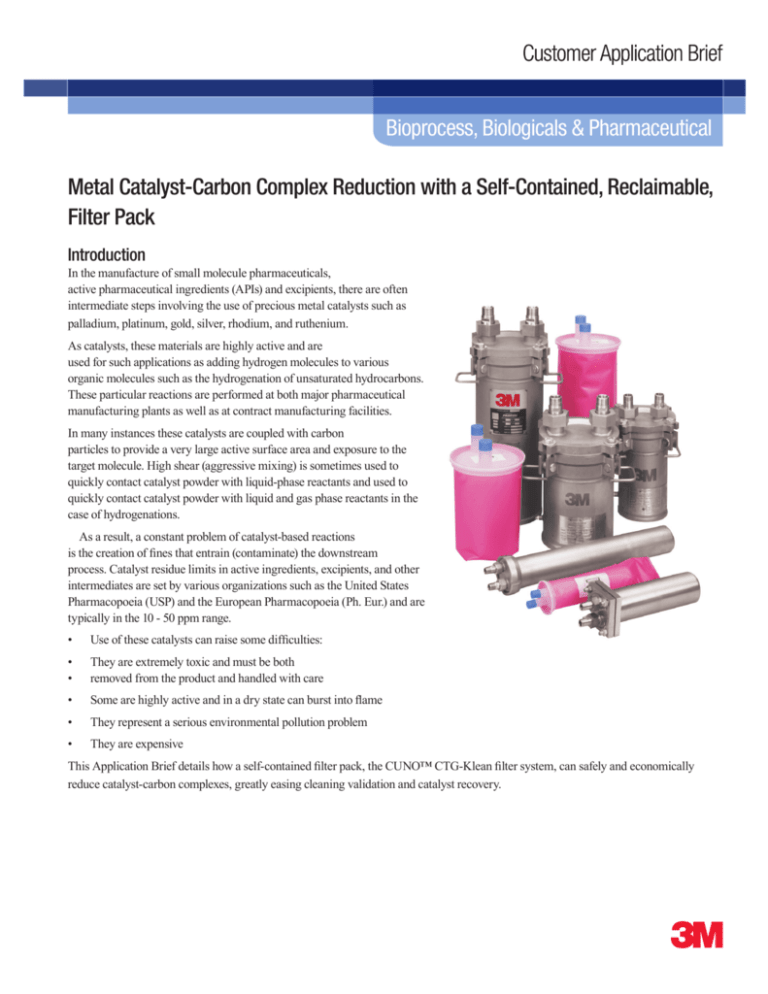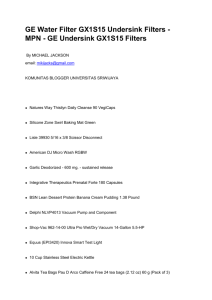
Customer Application Brief
Bioprocess, Biologicals & Pharmaceutical
Metal Catalyst-Carbon Complex Reduction with a Self-Contained, Reclaimable,
Filter Pack
Introduction
In the manufacture of small molecule pharmaceuticals,
active pharmaceutical ingredients (APIs) and excipients, there are often
intermediate steps involving the use of precious metal catalysts such as
palladium, platinum, gold, silver, rhodium, and ruthenium.
As catalysts, these materials are highly active and are
used for such applications as adding hydrogen molecules to various
organic molecules such as the hydrogenation of unsaturated hydrocarbons.
These particular reactions are performed at both major pharmaceutical
manufacturing plants as well as at contract manufacturing facilities.
In many instances these catalysts are coupled with carbon
particles to provide a very large active surface area and exposure to the
target molecule. High shear (aggressive mixing) is sometimes used to
quickly contact catalyst powder with liquid-phase reactants and used to
quickly contact catalyst powder with liquid and gas phase reactants in the
case of hydrogenations.
As a result, a constant problem of catalyst-based reactions
is the creation of fines that entrain (contaminate) the downstream
process. Catalyst residue limits in active ingredients, excipients, and other
intermediates are set by various organizations such as the United States
Pharmacopoeia (USP) and the European Pharmacopoeia (Ph. Eur.) and are
typically in the 10 - 50 ppm range.
•
Use of these catalysts can raise some difficulties:
•
•
They are extremely toxic and must be both
removed from the product and handled with care
•
Some are highly active and in a dry state can burst into flame
•
They represent a serious environmental pollution problem
•
They are expensive
This Application Brief details how a self-contained filter pack, the CUNO™ CTG-Klean filter system, can safely and economically
reduce catalyst-carbon complexes, greatly easing cleaning validation and catalyst recovery.
The Process
While many processes use metal catalyst in a variety of applications, the schematic in Figure 1 serves as a generic system by which to
illustrate the use of the CUNO™ CTG-Klean filter system to remove and reclaim catalyst.
Active Ingredient,
Catalysts and Solvent
Catalyst
Removal / Recovery
Guard Filter
OR
Pump
CUNO™ CTG-Klean
Filter System
Figure 1. - Generic Metal Catalyst Removal/Recovery System
Problems Associated with Catalyst Removal and Recovery
Worker and Environmental Exposure
In many processes, catalyst-carbon complexes are reduced downstream of the reaction vessel using one of three filtration methods: 1.
Neutsche, Sparklers, or similar plate-style filters, 2. disposable filter cartridges, or 3. bag filters. Plate filters are typically composed of a pressure
vessel containing a number of horizontal plates, each with an overlay of filter paper or fabric. In these filters, the catalyst is trapped on a filter
paper held between filter plates. In cartridge filter and bag filter operations, the catalyst is trapped on the surface of the filter medium.
In all instances, workers are exposed to catalyst, solvents, and other potentially dangerous compounds when the filters are reduced
and cleaned. Plate filters are particularly problematic in that they require extensive effort to unpack, clean, and repack, often requiring
two workers a total of 8 hours or more.
Limited Recovery Efficiency
Recovering expensive precious metal catalyst for reclamation and re-use is difficult using the conventional filter configurations
described above. Plate filters often have recesses where catalyst accumulates and cannot be easily accessed in the recovery process.
While less of a problem with disposable cartridge filters and bag filters, there is still an amount of catalyst that remains un-recoverable
and is lost during clean-up, typically in the filter housing base or valving.
Extensive Cleaning Validation
The FDA has increased its emphasis in API manufacture on properly designed, documented, and executed cleaning validation
protocols in recent years.
One point of particular concern is ensuring that all catalyst used in the process is accounted for at the end of the process. Using the
conventional filtration operations described above, it can be difficult to account for all the catalyst used in the reactor. Often these
systems allow for only a partial (90-98%) recovery of catalyst, begging the question: where is the remaining 2-10%? Assaying the final
product usually documents the absence of catalyst; therefore, the missing amount is often lost in the process, often in the filter vessel,
piping, and other equipment.
A second point of concern is ensuring that the equipment used in one process or batch is thoroughly cleaned before use in the next
process or batch, to prohibit cross-contamination and carry-over. Fixed, difficult to clean equipment, particularly plate filters, are often
cause for concern. Once the filter has been unpacked, it must be cleaned and flushed appropriately, with laboratory samples taken and
analyzed to confirm cleanliness and the absence of catalyst fines, before it can be repacked for the next use. Typically cleaning, and
especially validating the cleaning, requires greater time and effort than the original filtration itself.
2
The Solution:
The unique design of the CUNO™ CTG-Klean system has been found useful in dealing with catalyst reduction insofar as it offers an
easy and safe method of:
•
Filtering the catalyst out of the product
•
Providing complete capture of the catalyst
•
Sequestering the catalyst in a safe container that can be
•
filled with a quenching material if desired
•
Providing a container that can be returned to the foundry for precious metal recovery and regeneration
•
Easing cleaning validation concerns
The CUNO CTG-Klean system is a totally enclosed filtration
device that uses a separate pressure vessel and disposable filter pack
to isolate the product to be filtered from the housing. See figures 2 and
3.
CUNO CTG-Klean filter systems can accommodate a wide
variety of 3M Purification Inc. filter elements, including allpolypropylene depth filters (Betapure™ NT-T series), bi-component
depth filters (Betapure™ AU series), pleated, all polypropylene
Figure 2. - CUNO™ CTG-Klean System
surface filters (Betafine™ XL series and Betafine PEG, PBG, PPG &
PTG XL series), and sub-micronic membrane filters (LifeASSURE™ series). Filter systems provide retention ratings from 0.1m to 350m
and standard models can accommodate flow rates from 1 - 130 gpm (4 - 500 lpm). Please refer to 3M Purification literature number 700201-8693-1 for further details regarding available configurations and supplemental equipment.
Significantly Limits Exposure
In the CUNO CTG-Klean system, the filter cartridges are enclosed in a self-contained pack, eliminating excessive worker exposure
during filter change-out. Catalyst fines, solvents, and other hazardous compounds are contained within the pack and are not exposed to
the filter housing shell. At the end of the filtration run, the operator simply disconnects the inlet and outlet lines, caps the filter pack inlet
and outlet ports after removing the housing top plate, and
Inlet/Outlet
removes the entire filter pack.
Allows for Complete Catalyst Recovery
Since 100% of the fluid flows through the CUNO CTGKlean filter pack, all catalyst can be retained within the
pack. There is no fluid/catalyst contact with the filter
housing shell itself, as in conventional filters, so there is
no potential for catalyst to be caught in the recesses of the
housing. With proper filter and retention rating selection,
catalyst recovery is 100%. Furthermore, the unique design
of the CUNO CTG-Klean pack allows for easy transport
to a reclamation facility to recover expensive precious
metal catalyst. In fact, revenues from reclaiming catalyst
in this manner easily offset the cost of the CUNO CTGKlean system itself.
Cone
Connector
Cone
Nut
Ports
System
Head
& Swing Bolt
Closure
CUNO™
CTG-Klean
Housing
Upper & Lower
Cartridge
Seal Plates
Filter
Media
Housing
Vent
Filter Pack
Liner
Figure 3. - CUNO™ CTG-Klean System Features
3
Greatly Reduces Cleaning Validation
Since there is no exposure of product to the reusable CUNO™ CTG-Klean housing shell, cleaning validation is reduced considerably.
All product contact is with the filter pack alone, which is disposed of at the end of each run. Therefore, filter housing flushing, sampling
and laboratory analysis in regards to the filter housing are all obviated. This can drastically shorten the time needed to clean and prepare
a system for the next processing run, increasing plant capacity and lowering processing costs.
Conclusion and Summary:
The use of precious metal catalyst coupled with carbon is common in processing small molecule pharmaceuticals, APIs, excipients,
and other pharmaceutical intermediates. A constant problem of catalyst-based processes is the creation of fines that entrain
(contaminate) the downstream process. The use of precious metal catalyst coupled with carbon is common in processing small molecule
pharmaceuticals, APIs, excipients, and other pharmaceutical intermediates. A constant problem of catalyst-based processes is the
creation of fines that entrain (contaminate) the downstream process.
This Application Brief details how a self-contained filter pack, the CUNO CTG-Klean filter system, can safely and economically
remove catalyst-carbon complexes, greatly easing cleaning validation and catalyst recovery.
The CUNO CTG-Klean system:
• Significantly limits worker and environmental exposure to catalyst, solvents, and other potentially harmful compounds.
•
Allows for complete recovery of catalyst within the filter pack for easy disposal or reclamation.
•
Greatly eases cleaning validation resulting in faster turn-around time, increasing plant capacity and lowering overall processing
costs dramatically.
Important Notice
The information described in this literature is accurate to the best of our knowledge. A variety of factors, however, can affect the performance of the Product(s) in a particular
application, some of which are uniquely within your knowledge and control. INFORMATION IS SUPPLIED UPON THE CONDITION THAT THE PERSONS RECEIVING THE
SAME WILL MAKE THEIR OWN DETERMINATION AS TO ITS SUITABILITY FOR THEIR USE. IN NO EVENT WILL 3M PURIFICATION INC. BE RESPONSIBLE FOR DAMAGES
OF ANY NATURE WHATSOEVER RESULTING FROM THE USE OF OR RELIANCE UPON INFORMATION.
It is your responsibility to determine if additional testing or information is required and if this product is fit for a particular purpose and suitable in your specific application.
3M PURIFICATION INC. MAKES NO REPRESENTATIONS OR WARRANTIES, EITHER EXPRESS OR IMPLIED INCLUDING WITHOUT LIMITATION ANY WARRANTIES OF
MERCHANTABILITY, FITNESS FOR A PARTICULAR PURPOSE OR OF ANY OTHER NATURE HEREUNDER WITH RESPECT TO INFORMATION OR THE PRODUCT TO WHICH
INFORMATION REFERS.
Limitation of Liability
3M Purification Inc. will not be liable for any loss or damage arising from the use of the Product(s), whether direct, indirect, special, incidental, or consequential, regardless of
the legal theory asserted, including warranty, contract, negligence or strict liability. Some states do not allow the exclusion or limitation of incidental or consequential damages,
so the above limitation may not apply to you.
3M Purification Inc.
400 Research Parkway
Meriden, CT 06450
U.S.A.
Phone (800) 243-6894
(203) 237-5541
Fax
(203) 630-4530
www.3Mpurification.com
Please recycle. Printed in U.S.A.
3M is a trademark of 3M Company.
CUNO, Betafine, Betapure, and LifeASSURE are trademarks of
3M Company used under license.
© 2011 3M Company. All rights reserved.
70-0201-8627-9 REV 0911pb








